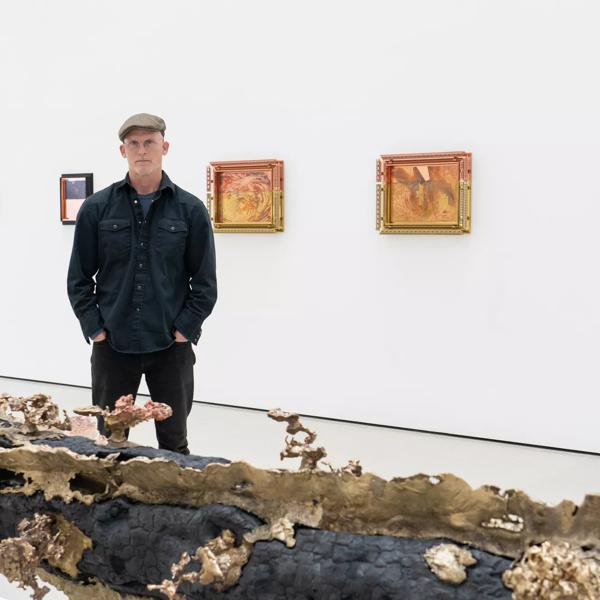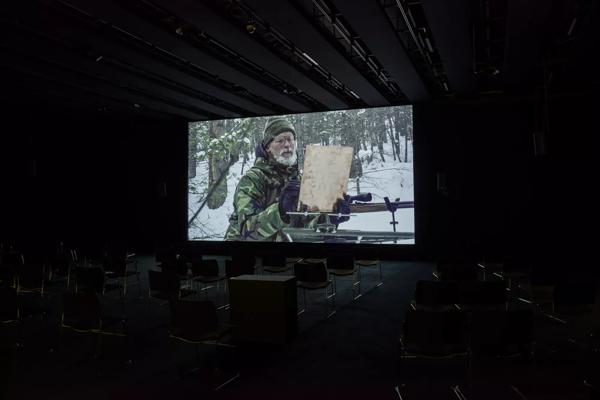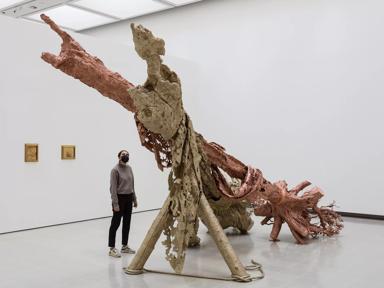Discussing Redoubt with Matthew Barney

Revealing a major new direction in the work of renowned artist and film-maker Matthew Barney, there’s little surprise that Redoubt at Hayward Gallery created such a fizz of anticipation.
‘There’s probably not a show in town with as much buzz around it as Matthew Barney’s Redoubt at Hayward Gallery,’ stated Time Out ahead of its opening. And the excitement didn't let up once we reopened our doors.
To get a greater insight into this remarkable exhibition, Hayward Gallery Assistant Curator, Katie Guggenheim caught up with Barney, to discuss what led the artist to Redoubt, as well as the significance of the landscape at its heart.
Katie Guggenheim: The film, sculptures, engravings and electroplates in this exhibition are all part of one body of work called Redoubt. How do these elements relate to one another and which came first?
Matthew Barney: Like other projects I’ve made with a film at the centre, Redoubt is a narrative system. The film functions like a creation myth for the objects and drawings. Drawing tends to come both first and last. It functions as a starting point or a way to map out the story, and then, after the film is made, sculptures and drawings are distilled from the narrative. Redoubt is unusual in that a number of drawings are characters within the film.
In the film you play the Engraver, who is a US Forest Service Ranger but also an artist, who sketches scenes from the wolf hunt onto copper plates. Who is this character and why did you choose to appear in this role?
When I was writing the script for Redoubt I was drawn to the myth of Diana and Actaeon as it gave some focus to some of the questions I was asking about the idea of possession in American Romantic landscape paintings from the nineteenth century. The Engraver, like Actaeon, is out hunting when he comes upon Diana and her virgins. In the film, when the Engraver sees Diana he is compelled to draw her image and the landscape around her.
I think most artists struggle with the question about the degree to which they possess their subject matter. I know I do, and particularly in a project like this, which combines content and imagery that I find beautiful, with content that I find problematic. I wanted to perform the role of the Engraver as a way of thinking more about these questions, but also to explore these questions through my drawing.

Other than the Engraver, the film has an all-female cast of dancers and a competitive sharpshooter. What was the casting process and how does dance intersect with other forms of movement in the work?
The characters in Redoubt are largely task-based, and that is also true of many characters in my previous films. Although I’ve worked with a lot of performers, I’ve worked with far fewer actors. For the role of Diana I started looking for a sharpshooter who was accurate at long range. I wanted Diana to shoot the copper plates that the Engraver had created; to leave streaks of lead across the face of the plate as another layer of mark-making. Just as the engravings were made in plein air, as you can see in the film, I wanted for the impact of Diana’s bullet to be real. Anette Wachter, who I cast in the role of Diana, was able to shoot with that level of accuracy.
The dance in the film was also approached with a similar kind of specificity. Sandra Lamouche is a specialist in Native American Hoop Dance. This dance form has a technical quality that aligns with some of the other types of movement in the film, such as aerial rope choreography and arborist tree climbing techniques; and the tactical language that the choreography draws on throughout the story.
Why did you choose a wolf hunt as the narrative structure of the film?
I was a teenager in Idaho in the 1980s and I remember the disagreement over a proposal to release a group of breeding pairs of Grey Wolves into the central Idaho wilderness, which took place in the 1990s. The conflict between the ecologists, who supported the reintroduction of the wolves, and the hunters and landowners who opposed it, captured something essential about the state and its political divide, which has been extreme for as long as I can remember. Given the place that wolves occupy in our imagination, the conversation took on a mythological scale, even for a young mind, and had a much greater meaning than the sum of the two arguments being voiced. I followed the progress of the reintroduction over the years, and always had in mind to take it on artistically.
‘I think most artists struggle with the question about the degree to which they possess their subject matter. I know I do’
The film was shot in 2016, which was in many ways the start of a period of crisis that we are still living through, characterised by political crises, the climate crisis and the Covid-19 pandemic.
The atmosphere of paranoia and isolation in Redoubt are almost prescient in this regard but what were you thinking about and responding to in the early stages of the project?
There is a movement in Idaho, eastern Oregon and Washington, and western Montana and Wyoming, which has been called, American Redoubt. It is one of a number of extremist movements in the States, which are about a separation from government and a return to the land. A redoubt typically refers either to the defence of a marginal belief or way of life, or a hidden military fortification. As the term refers to forms of isolation, it resonates for me in a more abstract way.
Central Idaho and southern Idaho are geographically isolated by the Rocky Mountains to the northeast, and the high desert to the southwest. When I lived there in the seventies and eighties, that isolation felt even more significant than it does now. With the Redoubt project I was interested in making a portrait of the region that would allow for a broader range of energies and expressions, both beautiful and problematic.

The idea of a site and its specificities and mythologies has been central to your work since the Cremaster Cycle, but Redoubt is the first film to foreground the natural world so directly. What is the significance for you of the Sawtooth Mountain region and of landscape more generally?
Between growing up in Idaho and living many years in New York City, the vertical landscape is the one I know the best. I have used mountainous locations in a number of films but Redoubt is the first piece I have made which takes place solely in that landscape.
One of the starting points for Redoubt was actually a set of questions I had about the representation of landscape in paintings of the American West and how that differs from Romantic landscape painting in northern Europe; how the posture of the figure depicted in the landscape does or doesn’t convey a sense of ownership or possession of the environment. I remember the first time I saw a Casper David Friedrich painting with a figure overlooking an alpine landscape in a stoic contrapposto stance, and thinking to myself that there’s no way an American could have made that painting. I’m most interested in the divergent mythologies at play in the two genres, which at first look quite similar. The European narrative seems to be about a stewardship over the land, whereas the American myth is to do with encountering a new frontier.
On a more personal level, Redoubt was an opportunity to think more about some of the mythologies I inherited growing up in the West.
The Hayward Gallery is an almost sculptural architecture made from cast concrete slabs. How are you finding the process of installing your work in and on the building?
I was immediately drawn to the way the Hayward feels like military architecture and how that quality could create a strong dialogue with some of the themes in the Redoubt project. But as I’ve been working in the building, I’m also realising how the presence of the sky through all the apertures on the upper floor brings out a quality in the sculpture that is meaningful.

Matthew Barney: Redoubt was at Hayward Gallery from 19 May until Sunday 25 July, 2021.
Lead image: Portrait of Matthew Barney. Photo: Takis Zontiros